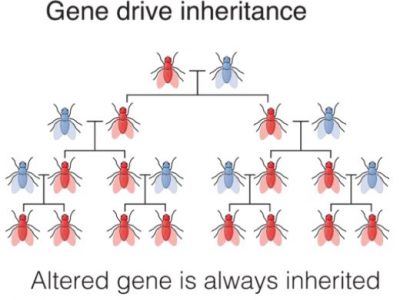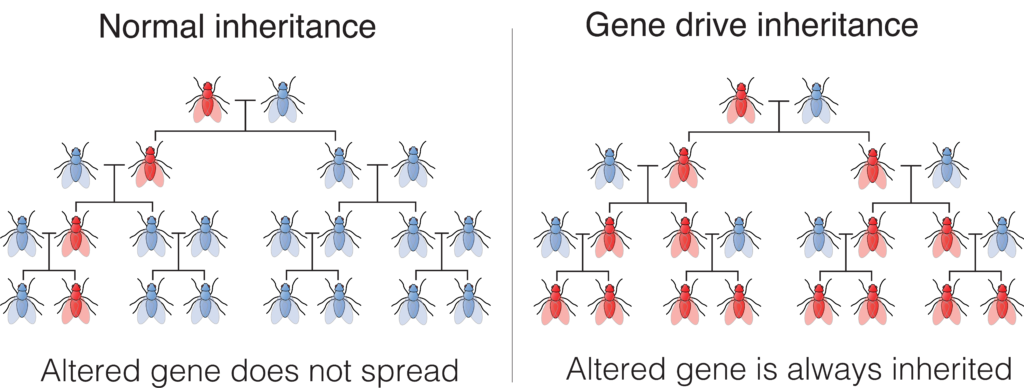
A set of new biotechnologies are being developed that will force many of us, especially those concerned about biodiversity loss, to re-examine how we understand the relationship between biotechnology and conservation. These are “gene drives,” which would be used to genetically modify, reduce, or eliminate populations of species. My paper “Governing New Biotechnologies for Biodiversity Conservation: Gene Drives, International Law, and Emerging Politics” was published today in Global Environmental Politics. (For those without access, here is a pre-print of it [PDF].)
Attentive readers may recall that I introduced gene drives and their governance in blog posts last year. Briefly: sexually reproducing organism receive genes from both of their parents and normally have a 50% change of passing on each of these variants to an offspring. A gene drive is a genetic modification that copies itself to the other pair of genes in a cell. Because all offspring of a “gene drive organism” will inherit the gene drive, the modified genetic trait can spread through a population (meaning the interbreeding members of a species that typically live in a geographic place) within a few generations. This is useful because most genetic modifications that humans might want wild species to have are disadvantageous in terms of reproductive fitness. Importantly, gene drives would work only on species that reproduce sexually (so no bacteria) and have short life cycles (so no humans or other large mammals).

Most interest in gene drives has been for human public health, specifically by eradicating disease-carrying mosquitoes — which are the world’s deadliest organism. However, I am most interested in the possible uses of gene drives for biodiversity conservation: by eradicating invasive alien species or by helping endangered species, through increasing disease resistance or climate climate resilience.
As the subtitle indicates, my paper reviews and analyzes international law and the associated emerging politics. With regard to the former, the Convention on Biological Diversity (CBD) and Cartagena Protocol on Biosafety are most applicable, with intergovernmental institutions such as the Intergovernmental Science-Policy Platform on Biodiversity and Ecosystem Services, World Health Organization, and International Union for Conservation of Nature (IUCN) playing secondary roles. The CBD’s Conference of Parties (COP) [PDF] and the IUCN’s World Conservation Congress have each issued official decisions on gene drives as part of decisions on “synthetic biology” more generally. These strike cautious tones (for example, calling “upon Parties and other Governments … to apply a precautionary approach”).
I find the political dynamics associated with the CBD and IUCN decision-making to be fascinating. I compare them with those of agricultural genetically modified organisms (GMOs), which were prominent issues in international environmental policy in the 1990s and 2000s. I see some relevant similarities between them:
- Industrialized countries have adopted similar positions with respect to the two sets of technologies, with English-speaking ones leaning toward research and development and continental Europe favoring strict regulation or moratoriums.
- Most of the activists and “green” advocacy organizations that resist gene drives also opposed GMOs in the 1990s and 2000s.
- The gene drive debates are playing out at the same intergovernmental forums as those for agricultural GMOs.
- Divergent understandings of precaution have played a central role in how actors have responded to both sets of technologies.
I further note five salient differences:
- Scientists remained largely quiet the during the agricultural GMO debates but are now pro-active with respect to possible international governance of gene drives.
- Most major environmental advocacy organizations have thus far taken no position on gene drives, and at least one such group (Island Conservation) supports their research and development. In contrast, many were vocal skeptics or opponents of agricultural GMOs.
- As I describe above, the two sets of biotechnologies have differing implications for the conservation of biological diversity, or at least the perceptions thereof.
- Agricultural GMOs were mostly developed and promoted by large businesses that sought to profit. In contrast, the private sector has been almost entirely absent from gene drives’ research. This is an expected consequence of the former’s “private good” character (in the economic sense of the word, in that the user can capture most of their effects and exclude others from benefiting) and the latter’s “public good” one (the user can neither capture most of their effects nor exclude others from benefiting). Thus, the likely users of gene drives are (quasi) public bodies: governments, charities, etc.
- Perhaps most importantly, the positions of developing countries—especially the poorer ones in Africa—are now different. In the 1990s and 2000s, they generally rejected agricultural GMOs or limited their use to cotton. But now, the African Union has worked at the CBD COPs to ensure that gene drives may be researched and developed. This is in large part due to the scourge of malaria, the fifth leading cause of death in Africa.
Both the CBD COP and the IUCN World Conservation Congress were to revisit the governance of gene drives this year, but these meetings have been postponed to 2021.
I close my paper with this wider observation:
Ultimately, this politics of [gene drives organisms’] governance is a manifestation of a larger struggle regarding emerging technologies among those concerned about sustainability. Many environmentalists resist these technologies when they are centralized, invisible, relatively unfamiliar, and in others’ control, such as nuclear power, climate geoengineering, and gene drives. Yet, in a persistent echo of the movement’s “small is beautiful” principle, environmentalists are often quick to embrace those that are decentralized, visible, relatively familiar, and in consumers’ control, such as solar panels, insulation, and electric cars. Whether we proceed with contested technologies is, to a degree, political. Yet whether we can both conserve biodiversity and improve the well-being of the world’s peoples with decentralized technologies is largely an empirical matter.
The post Gene Drives, Biodiversity Conservation, International Law, and Emerging Politics appeared first on Legal Planet.
By: Jesse Reynolds
Title: Gene Drives, Biodiversity Conservation, International Law, and Emerging Politics
Sourced From: legal-planet.org/2020/09/04/gene-drives-biodiversity-conservation/
Published Date: Fri, 04 Sep 2020 13:30:24 +0000
Vist Maida on Social Me
Website Links
Maida Law Firm - Auto Accident Attorneys of Houston, by fuseology
No comments:
Post a Comment